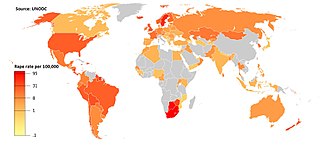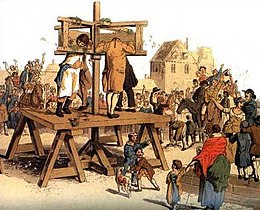
A sex worker is a person who provides sex work, either on a regular or occasional basis. The term is used in reference to those who work in all areas of the sex industry.

Shame is an unpleasant self-conscious emotion often associated with negative self-evaluation; motivation to quit; and feelings of pain, exposure, distrust, powerlessness, and worthlessness.

Scapegoating is the practice of singling out a person or group for unmerited blame and consequent negative treatment. Scapegoating may be conducted by individuals against individuals, individuals against groups, groups against individuals, and groups against groups.

Suffering, or pain in a broad sense, may be an experience of unpleasantness or aversion, possibly associated with the perception of harm or threat of harm in an individual. Suffering is the basic element that makes up the negative valence of affective phenomena. The opposite of suffering is pleasure or happiness.

Sex work is "the exchange of sexual services, performances, or products for material compensation. It includes activities of direct physical contact between buyers and sellers as well as indirect sexual stimulation". Sex work only refers to voluntary sexual transactions; thus, the term does not refer to human trafficking and other coerced or nonconsensual sexual transactions such as child prostitution. The transaction must take place between consenting adults of the legal age and mental capacity to consent and must take place without any methods of coercion, other than payment. The term emphasizes the labor and economic implications of this type of work. Furthermore, some prefer the use of the term because it grants more agency to the sellers of these services.

Bullying is the use of force, coercion, hurtful teasing or threat, to abuse, aggressively dominate or intimidate. The behavior is often repeated and habitual. One essential prerequisite is the perception of an imbalance of physical or social power. This imbalance distinguishes bullying from conflict. Bullying is a subcategory of aggressive behavior characterized by hostile intent, imbalance of power and repetition over a period of time.
Sexual violence is any harmful or unwanted sexual act or attempt to obtain a sexual act by violence or coercion, act to traffic a person, regardless of the relationship to the victim. This includes forced engagement in sexual acts, attempted or completed acts and occurs without the consent of the victim. It occurs in times of peace and armed conflict situations, is widespread, and is considered to be one of the most traumatic, pervasive, and most common human rights violations.
Sympathy is the perception of, understanding of, and reaction to the distress or need of another life form.

Resentment is a complex, multilayered emotion that has been described as a mixture of disappointment, disgust and anger. Other psychologists consider it a mood or as a secondary emotion that can be elicited in the face of insult or injury.

Rape culture is a setting, studied by several sociological theories, in which rape is pervasive and normalized due to societal attitudes about gender and sexuality. Behaviors commonly associated with rape culture include victim blaming, slut-shaming, sexual objectification, trivializing rape, denial of widespread rape, refusing to acknowledge the harm caused by sexual violence, or some combination of these. It has been used to describe and explain behavior within social groups, including prison rape and in conflict areas where war rape is used as psychological warfare. Entire societies have been alleged to be rape cultures.
Rape can be categorized in different ways: for example, by reference to the situation in which it occurs, by the identity or characteristics of the victim, and by the identity or characteristics of the perpetrator. These categories are referred to as types of rape. The types described below are not mutually exclusive: a given rape can fit into multiple categories, by for example being both a prison rape and a gang rape, or both a custodial rape and the rape of a child.
Rape is a traumatic experience that affects the victim in a physical, psychological, and sociological way. Even though the effects and aftermath of rape differ among victims, individuals tend to suffer from similar issues found within these three categories. Long-term reactions may involve the development of coping mechanisms that will either benefit the victim, such as social support, or inhibit their recovery. Seeking support and professional resources may assist the victim in numerous ways.

Evelin Gerda Lindner is a German-Norwegian medical doctor, psychologist, transdisciplinary scholar and author who is known for her theory of humiliation.
Violence against prostitutes occurs worldwide, both through physical and psychological forms. The victims are predominantly women. In extreme cases, violent acts have led to their murder while in their workplace.
Victimization refers to a person being made into a victim by someone else and can take on psychological as well as physical forms, both of which are damaging to victims. Forms of victimization include bullying or peer victimization, physical abuse, sexual abuse, verbal abuse, robbery, and assault. Some of these forms of victimization are commonly associated with certain populations, but they can happen to others as well. For example, bullying or peer victimization is most commonly studied in children and adolescents but also takes place between adults. Although anyone may be victimized, particular groups may be more susceptible to certain types of victimization and as a result to the symptoms and consequences that follow. Individuals respond to victimization in a wide variety of ways, so noticeable symptoms of victimization will vary from person to person. These symptoms may take on several different forms, be associated with specific forms of victimization, and be moderated by individual characteristics of the victim and/or experiences after victimization.
Bullying suicide are considered together when the cause of suicide is attributable to the victim having been bullied, either in person or via social media. Writers Neil Marr and Tim Field wrote about it in their 2001 book Bullycide: Death at Playtime.
Sex worker abuse by police officers can occur in one or more ways. Police brutality refers to the intentional use of excessive force by a police officer, be it physical, verbal, or psychological. Police corruption is a form of police misconduct where an officer obtains financial benefits and/or career advancements in exchange for not pursuing, or selectively pursuing, an investigation or arrest. Police misconduct refers to inappropriate actions taken by police officers in connection with their official duties. Sex workers, particularly poor sex workers and those who had been manipulated, coerced, or forced into sex work, are at risk of being obliged or otherwise forced to provide free sexual services to police officers out of fear of being harmed or arrested. Some sex workers have reported that they have encountered police officers who have physically assaulted them without evidence of a crime and without making an arrest.
Suicide awareness is a proactive effort to raise awareness around suicidal behaviors. It is focused on reducing social stigmas and ambiguity by bringing attention to suicide statistically and sociologically, and by encouraging positive dialogue and engagement to prevent suicide. Suicide awareness is linked to suicide prevention as both address suicide education and the dissemination of information to ultimately decrease the rate of suicide. Awareness is the first stage that can ease the need for prevention. Awareness signifies a fundamental consciousness of the threat, while prevention focuses on stopping the act. Suicide awareness is not a medical engagement but a combination of medical, social, emotional and financial counseling. Suicide awareness in adolescents focuses on the age group between 10–24 years, beginning with the onset of puberty.
Vicarious embarrassment is the feeling of embarrassment from observing the embarrassing actions of another person. Unlike general embarrassment, vicarious embarrassment is not the feelings of embarrassment for yourself or for your own actions, but instead by feeling embarrassment for somebody else after witnessing that other person experiences an embarrassing event. These emotions can be perceived as pro-social, and some say they can be seen as motives for following socially and culturally acceptable behavior.
Secondary victimisation refers to further victim-blaming from criminal justice authorities following a report of an original victimisation.














